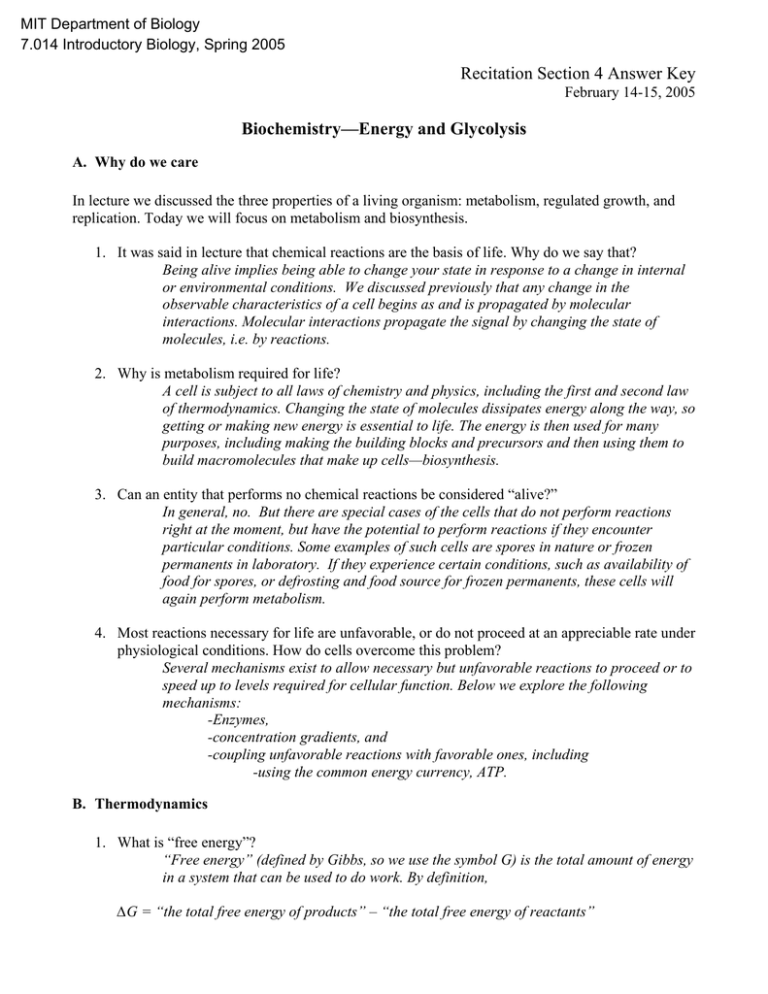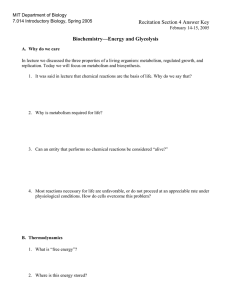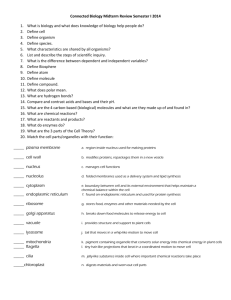Recitation Section 4 Answer Key Biochemistry—Energy and Glycolysis
advertisement

MIT Department of Biology
7.014 Introductory Biology, Spring 2005
Recitation Section 4 Answer Key
February 14-15, 2005
Biochemistry—Energy and Glycolysis
A. Why do we care
In lecture we discussed the three properties of a living organism: metabolism, regulated growth, and
replication. Today we will focus on metabolism and biosynthesis.
1. It was said in lecture that chemical reactions are the basis of life. Why do we say that?
Being alive implies being able to change your state in response to a change in internal
or environmental conditions. We discussed previously that any change in the
observable characteristics of a cell begins as and is propagated by molecular
interactions. Molecular interactions propagate the signal by changing the state of
molecules, i.e. by reactions.
2. Why is metabolism required for life?
A cell is subject to all laws of chemistry and physics, including the first and second law
of thermodynamics. Changing the state of molecules dissipates energy along the way, so
getting or making new energy is essential to life. The energy is then used for many
purposes, including making the building blocks and precursors and then using them to
build macromolecules that make up cells—biosynthesis.
3. Can an entity that performs no chemical reactions be considered “alive?”
In general, no. But there are special cases of the cells that do not perform reactions
right at the moment, but have the potential to perform reactions if they encounter
particular conditions. Some examples of such cells are spores in nature or frozen
permanents in laboratory. If they experience certain conditions, such as availability of
food for spores, or defrosting and food source for frozen permanents, these cells will
again perform metabolism.
4. Most reactions necessary for life are unfavorable, or do not proceed at an appreciable rate under
physiological conditions. How do cells overcome this problem?
Several mechanisms exist to allow necessary but unfavorable reactions to proceed or to
speed up to levels required for cellular function. Below we explore the following
mechanisms:
-Enzymes,
-concentration gradients, and
-coupling unfavorable reactions with favorable ones, including
-using the common energy currency, ATP.
B. Thermodynamics
1. What is “free energy”?
“Free energy” (defined by Gibbs, so we use the symbol G) is the total amount of energy
in a system that can be used to do work. By definition,
∆G = “the total free energy of products” – “the total free energy of reactants”
2. Where is this energy stored?
The energy is stored in the bonds of the reactant and product molecules.
We say that ∆G is a thermodynamic property, meaning that it is independent of the way that the
conversion of reactants to products might proceed.
3. Based on how energy is stored in the molecules, explain why ∆G is independent of the path of
the reaction.
The energy is stored in the bonds. Regardless of how the reaction proceeds (all in one
step, or in 10 steps, like glycolysis), the products will still look like the same exact
molecules. Thus, the amount of energy stored in the bonds of the products will still be
the same, and the difference in energy levels between reactants and products will still
be the same.
4. If ∆G=0, the reaction is at equilibrium. What then is the meaning of the magnitude of ∆G?
The magnitude of ∆G is the measure of the amount of work that can be done by a
chemical reaction before it reaches equilibrium.
5. What is a favorable reaction? What would ∆G be for a thermodynamically favorable reaction?
A favorable, or exergonic, reaction is one in which the energy state of reactants is
higher than that of the products (∆G<0).
6. What is an unfavorable reaction? What would ∆G be for a thermodynamically unfavorable
reaction?
An unfavorable, or endergonic, reaction is the one in which the energy state of the
products is higher than that of the reactants (∆G>0).
7. Not all thermodynamically favorable reactions proceed on their own. Why?
Some reactions with negative ∆G still do not proceed at an appreciable rate. This is
usually because some intermediate is in a significantly higher energy state than the
reactants. The difference between the energy state of the reactants and such an
intermediate is known as activation energy (Ea).
8. Catalysts overcome this problem. How do they do it?
Catalysts (most often protein enzymes) lower the activation energy of the reaction, thus
allowing the reaction to proceed. They sometimes accomplish this by physically
positioning reactants in a way that brings parts of the molecules that will participate in
the reaction in close contact.
Free Energy
A
B
C
Transition
ansition state
Ea
A+B
BC
Reactants
Figure by MIT OCW.
Ñ
Free Energy
A B C
Transition state
G
Ea without
enzyme
A + BC
B
Ea with
enzyme
Reactants
AB + C
AB + C
Products
Products
Figure by MIT OCW.
9. Is the equilibrium of the reaction affected by the action of a catalyst? Why or why not?
The equilibrium of the reaction (relative concentrations of reactants and products) is
not affected by the presence of the catalyst. This is because the equilibrium is
determined by the amount of energy available to perform the work of converting
reactants to products and vice versa. Since the energy is stored in the bonds, it is
independent of the path the reaction takes, or the rate at which it occurs.
10. Is the rate of the reaction affected by the action of a catalyst? Why or why not?
The rate of reaction is affected. Reactants reach the transition state due to random
fluctuations in energy caused by molecular motion. If Ea is lowered, much less energy is
required to reach it, so more molecules will be able to do so, and the rate of the
reaction will increase.
11. Why can the direction in which a reaction proceeds be influenced by the relative concentration
of reactants and products?
If you have more molecules of a particular kind, it is more probable that some of them
will reach the high energy state of the transition state.
C. Kinetics
As mentioned in lecture, effect of enzymes can be quantified. The measures commonly used, Km and
Vmax are characteristic of different aspects of enzyme’s actions. To illustrate these concepts, we will
break into groups of four for the following experiment.
All members of the group will try to pick up from the desk and open as many eppendorf tubes as
possible in a 45 second interval. One member in each group will use the hand with taped down thumb,
another with the other four fingers taped together, and the last person will use a hand in a ski glove.
1. How many eppendorf tubes was each member of the team able to pick up and open in 45
seconds?
hand
-thumb
-fingers
ski glove
low
medium
high
2. What problems with enzyme functions does the demo represent?
Problems illustrated by the demo—defective binding interactions with substrates (taped
fingers), ability to catalyze the reaction (taped thumb), similar but wrong enzyme (ski
glove).
Data gathered in an enzyme kinetics experiment can be represented on a graph of concentration of
substrate vs. initial rate of the reaction.
Vmax
V
Vmax/2
Figure by MIT OCW.
KM
[S]
Initial Rate, v
3. Why does the curve level off?
Vmax is the property of the enzyme at a fixed concentration. The curve levels off because
the enzyme is saturated. It doesn’t have to go looking for substrate—there is so much of
it around, that the rate-limiting step is actually the catalysis.
Km is the measure of how well an enzyme binds the substrate—the less substrate it takes to achieve
half maximal speed, the better is the affinity of the enzyme for the substrate.
4. How would the curve below change for the mutants described in the demo?
Substrate Concentration, [S]
Figure by MIT OCW.
For the mutant defective in binding the substrate, Km would be higher, but Vmax should
remain the same—if enzyme is saturated, the catalysis is the rate-limiting step.
For the mutant defective in the active site, Vmax would decrease. Km might actually
decrease as well due to the maximal speed being lower than before, while the affinity
for the substrate stays the same.
For the similar, but wrong enzyme, Km would likely rise, while Vmax falls—the affinity is
worse, and the catalysis is slower.
D. Energy currency
Enzymes can not make thermodynamically unfavorable reactions proceed. But they do lower the
activation energy of a reaction in both directions.
1. What strategy can a cell use to drive slightly thermodynamically unfavorable catalyzed reactions? How can this be achieved in a cell? As discussed above, skewing the concentrations in favor of reactants can drive such a
reaction forward. This can be achieved by immediately siphoning off any newly formed
products, thus maintaining the concentration gradient.
Sometimes the reaction is just too thermodynamically unfavorable to be driven by such tricks.
2. What is the strategy used by the cell to drive such reactions?
In the cell, energetically unfavorable reactions are often coupled with favorable ones,
such that the new overall reaction is favorable.
We say that ATP is the energy currency of the cell.
3. Why does it make sense to have energy currency?
By producing ATP whenever possible, the cell can store the excess energy to fuel
endergonic reactions whenever needed.
4. Where in ATP is the energy available to do work stored?
In ATP energy is stored in the bonds. The most unfavorable of these bonds is the bond
between the second and third phosphates.
5. What makes ATP a good candidate for the position of energy currency in the cell?
The third phosphate can be removed, releasing a lot of energy. This phosphate can
actually be transferred to one of the reactants, taking that molecule to a higher energy
state, and allowing a previously non-spontaneous reaction to proceed.
ATP is also a building block of RNA.
6. Given what you know about the early history of life on Earth, why does this make sense?
It is believed that early in evolution there were very few molecules around. The
triphosphate feature of ATP made it a good candidate for energy storage, and once the
pathway was developed, it became a selective liability to change it too much.
As we discussed on the first day of class, many key pathways, such as glycolysis, are
ancient, and trace their origin to the early stages of evolution of life on Earth.
E. Glycolysis
Glycolysis is an ancient pathway. It is critically important for producing ATP. It is an incremental
pathway, meaning that it takes a number of steps (10) to get from the initial reactant (glucose) to the
final products. Below in the energy diagram of glycolysis.
Glycolysis
60
50
40
30
G3P
10
G6P
0
F6P
FBP
{
Change in free energy, ∆G (in kilocalories)
20
G3P + DAP
-10
-20
Glucose
-30
-40
Figure by
MIT OCW.
-50
-60
-70
-80
-90
-100
-110
-120
BPG
3PG
2PG
PEP
-130
-140
Pyruvate
-150
As you can see from the diagram, the overall reaction is very favorable (∆G < -130).
1. Why do the first six steps of the pathway have a positive ∆G?
The pathway involves adding energy to reactants until the can extract energy from
them.
2. Is this the most efficient way to design a pathway glucoseÆ pyruvate? If you were able to
design it de novo, would you be able to come up with a better way?
The pathway is likely not the most efficient possible. There are likely much more
efficient solutions possible.
3. As we mentioned a number of times, this pathway is highly evolutionarily conserved. Why?
Once the pathway was developed, any mutant (M) of the pathway that accidentally
arises is likely to be less efficient at extracting ATP from glucose. Even if some
descendant of M, M1, if it was to acquire another mutation, might end up being
significantly better than the original non-mutant organism, M itself is not likely to
survive or generate enough progeny to allow M1 to ever appear. Thus, evolutionary
pressure works against changes to key pathways, ensuring significant conservation
throughout evolution.
4. Speculate about how this pathway might have arisen.
Maybe could get ATP from 1,3diphosphoglycerate. Developed an enzyme to get from
G3P to 1,3…. Etc. Energy investment to get up to the certain level from which can get
down.
5. What is the energy gain from the glycolysis pathway?
The net energy gain from glycolysis is only 2 ATP molecules.
6. Is this enough energy to allow for the development of the diverse set of organisms populating
the biosphere?
No, the gain of 2ATP molecules from a molecule of glucose is not enough to fuel more
complicated organisms that populate the biosphere today. For that, photosynthesis and
respiration needed to develop. This is why it can be said that O2 is the engine of
evolution. We will look at these new ways of making ATP in the next section.




